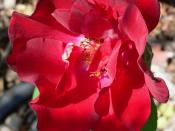In the New Testament it states that 'the wages of sin is death.' Though the
penalty of sin in The Scarlet Letter is not a termination of life, the evil of isolation can be
a physically, morally, and socially tortuous event in Puritan society. Hester Prynne and
Arthur Dimmesdale, in Hawthorne's The Scarlet Letter, are both victims of the cruel
isolation from Puritan society on the basis of their sins. Hester wears her sin upon her
breast where it stands as a constant reminder of her malfeasance. Shame and isolation
strip her of all passion and femininity, leaving her a shell of her former self. Though
Arthur's mark of shame is not visible, it is all the more tortuous for its absence. Shame
and guilt feed upon Arthur's soul with slow malevolency. Only a combination of death
and confession finally release Arthur from his torture.
Though Hester's ostracism from society and the tortuous nature of her shame,
Hester is stripped of all passion and humanity.
Since society acknowledges Hester's sin,
she becomes an exile in her own town. 'All the world Ha[s] frowned on her,' and Hester
must bear the brunt of her shameful isolation. When Hester walks through her town 'a
sort of magic circle [forms] itself around her.' Devoid of any social contact, save that of
her daughter, Hester must endure of lonely existence. 'In all her intercourse with society,
save that of her daughter, there was nothing that made [Hester] feel as if she belonged to
it.'; therefore, she turns to herself for reflection of her shame. When Hester must walk
through the town, she suffers 'an agony from every footstep.' Frequent suffering does not
inure Hester to her inner torment; instead, the same grows' more sensitive with daily
torture.' Hester's ostracism from a stoic society...


